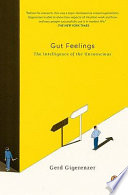

While intuition is valuable, the book stresses the importance of balancing gut feelings with analytical thinking. The author suggests that effective decision-making often requires a combination of both approaches. Intuition can provide quick insights, while analysis can help validate those insights. The book offers strategies for integrating intuition and analysis, such as using intuition as a starting point and then applying analytical methods to support or challenge those initial feelings. This balanced approach allows for more comprehensive decision-making.
Continue readingThe book emphasizes that intuition is a crucial aspect of decision-making. It argues that gut feelings, often dismissed as irrational, are actually informed by our experiences and knowledge. The author presents research showing that intuitive decisions can be as effective as analytical ones, especially in complex situations where not all variables can be accounted for. This idea challenges the traditional view that rationality is the only valid approach to decision-making. By understanding and trusting our gut feelings, we can enhance our decision-making skills and navigate uncertainty more effectively.
Continue readingThe author delves into the neuroscience behind gut feelings, explaining how our brains process information and how emotions play a significant role in our decisions. Studies are presented that illustrate how the gut-brain connection influences our feelings and choices. The book discusses the physiological responses that accompany gut feelings, such as changes in heart rate and hormone levels. This scientific perspective helps ground the concept of intuition in biological processes, making it more relatable and credible for readers who may be skeptical about the validity of gut feelings.
Continue readingExperience is a key component in developing intuition. The author argues that our past experiences shape our gut feelings, enabling us to make quicker and more accurate decisions. The book highlights how experts in various fields often rely on their intuition, which has been honed through years of practice and exposure to similar situations. This idea encourages readers to value their own experiences and learn from them, as they contribute to the development of their intuitive skills.
Continue readingThe book explores how cultural factors shape our understanding and use of intuition. Different cultures may have varying attitudes towards gut feelings, with some viewing them as valuable and others as unreliable. The author discusses how these cultural perceptions can influence decision-making processes in personal and professional contexts. By recognizing these influences, readers can better understand their own biases and improve their decision-making by considering diverse perspectives.
Continue readingStress can significantly affect our ability to make intuitive decisions. The book examines how high-pressure situations can cloud judgment and lead to poor decision-making, as stress can inhibit the brain's ability to process information effectively. The author provides insights into managing stress to enhance decision-making capabilities. Techniques such as mindfulness and stress reduction strategies are discussed, highlighting their importance in maintaining clarity and trust in our gut feelings.
Continue readingThe final key idea focuses on the practical applications of gut feelings in various aspects of life, including business, relationships, and personal growth. The author shares real-life examples and case studies that illustrate how individuals and organizations have successfully leveraged their intuition to make impactful decisions. This section encourages readers to apply the concepts learned throughout the book in their own lives, emphasizing that trusting one's gut can lead to significant positive outcomes.
Continue reading